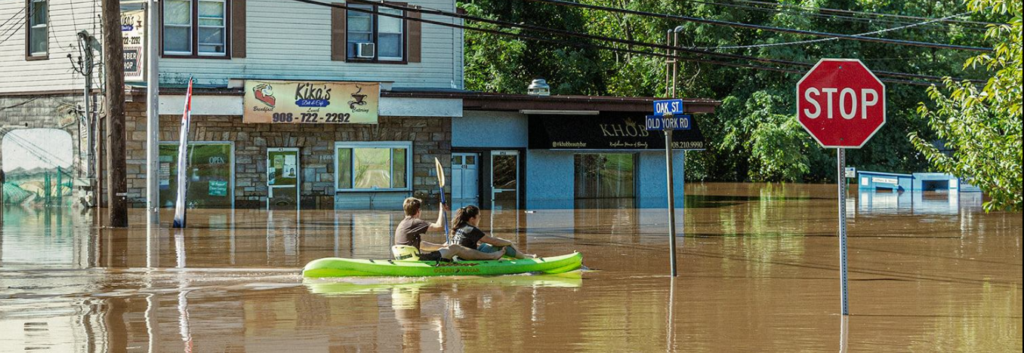The State We're In
Warm air, more rain and more floods: the new normal
By Michele S. Byers, Executive Director, 1999-2021
New Jersey experienced its worst flooding in years on Sept. 1, when the remnants of Hurricane Ida dumped up to 11 inches of rainfall on a landscape already saturated from previous storms, including Hurricane Henri just 10 days earlier.
Heavy rainfall was expected, but the torrential downpour and speed of rising waters took this state we’re in by surprise. Thirty New Jerseyans died in the flash floods – more than in any other state – and hundreds of homes and businesses were damaged or destroyed. Eleven of New Jersey’s 21 counties were declared federal disaster areas.
Ida dropped as much as 3-4 inches of rain per hour in some areas, and at least eight rivers and creeks set new records for flood stages.
According to climate scientists, a hotter atmosphere causes more evaporation, especially from the oceans. Once the atmosphere becomes saturated with moisture, precipitation is released during storms. In the case of Ida, the hurricane’s core moisture came up from the Gulf of Mexico and merged with another storm system to produce huge rainfalls across a wide swath of New Jersey, eastern Pennsylvania and southern New York.
Compounding the flooding is the proliferation of impervious surfaces like asphalt and concrete. As more of New Jersey is paved over, fewer places are left for water to be absorbed into the ground. As Ida proved, excessive storm runoff can quickly turn deadly.
The bad news is there’s no clear end in sight. A sobering new report by the Intergovernmental Panel on Climate Change, a body of scientists convened by the United Nations, concludes that many devastating impacts of global warming are now unavoidable. However, the report stated, it’s still possible to take action to avoid a worst-case scenario.
According to the report:
- It is “unequivocal” that human activities have warmed the atmosphere, ocean and land. Increases in carbon dioxide in the Earth’s atmosphere can be directly tied to the burning of coal, oil and other fossil fuels.
- The scale of recent changes are “unprecedented” over a period of many centuries to many thousands of years.
- Human-induced climate change is already affecting weather and climate extremes in every region across the globe. Impacts include heat waves, heavy precipitation, droughts and tropical cyclones.
- The world has already warmed about 2 degrees Fahrenheit (1.1 degree Celsius) since the 19th century. It is unavoidable that global surface temperatures will continue to rise during the next 30 years to at least 2.7 degrees Fahrenheit (1.5 degrees Celsius) above pre-industrial levels.
- But there’s still a chance to alter the climate path by taking aggressive and immediate action. If deep and widespread emissions cuts are made immediately, global temperatures could stabilize by about 2050. Under the most optimistic of the report’s five scenarios, reaching “net zero” emissions could even bring about a slight temperature reduction in the second half of the century.
There’s no longer a credible doubt that drastic reductions in emissions, along with a rapid transition to renewable energy, like wind and solar, is necessary to prevent the worst impacts of climate change!
New Jersey is already working toward its target of reaching 100 percent clean energy by 2050. New Jersey Conservation Foundation recently joined the New Jersey League of Conservation Voters and others in calling for a more aggressive target of 100 percent zero-carbon electricity by 2035.
Changes in land management practices, particularly in agriculture can help provide a natural solution. Land management that sequesters carbon can mitigate the impacts of climate change. Many states, including New Jersey, are developing natural and working lands strategies.
Perhaps we could learn from The Netherlands – one of the world’s lowest-lying nations –about how to reduce deadly flooding by creating and expanding flood plains along rivers.
Earlier this summer, Dutch officials completed a 1,300-acre flood plain along the Maas River. The project was quickly put to the test when flood waters from torrential rains in Germany and Belgium were bearing down on the Netherlands. The new flood plain did exactly what it was supposed to, absorbing enough water that river levels dropped and flooding was averted in downstream cities.
The New Jersey Blue Acres Program is buying out flood prone properties, removing structures and restoring the land to natural conditions. More funding and investment is needed for these voluntary buy-outs, ideally supplemented by federal funding, to help frequently hard-hit communities like Manville.
To read the Intergovernmental Panel on Climate Change study, go to https://www.ipcc.ch/report/ar6/wg1/.
To learn more about New Jersey’s Blue Acres Program, go to https://www.nj.gov/dep/greenacres/blue_flood_ac.html.
To read about the Dutch efforts to create flood plains, go to https://www.nytimes.com/2021/09/07/world/europe/dutch-rivers-flood-control.html.
And to learn more about preserving New Jersey’s land and natural resources, visit the New Jersey Conservation Foundation website at www.njconservation.org or contact me at info@njconservation.org.
About the Authors
Alison Mitchell
Co-Executive Director
John S. Watson, Jr.
Co-Executive Director
Tom Gilbert
Co-Executive Director, 2022-2023
Michele S. Byers
Executive Director, 1999-2021
View their full bios here.
Filter
Get The Latest News
From The Garden State
In the
News

